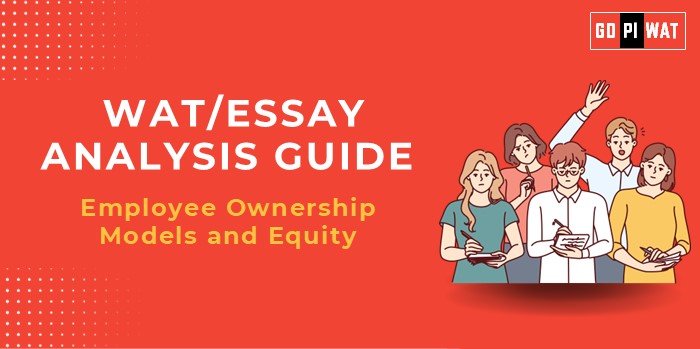📋 WAT/Essay Analysis Guide: Understanding Employee Ownership Models and Equity
🌐 Understanding the Topic’s Importance
“Employee ownership models represent a transformative approach to wealth distribution, fostering equity while enhancing organizational engagement and productivity.”
📝 Effective Planning and Writing
- Time Allocation:
- Planning: 5 mins
- Writing: 20 mins
- Review: 5 mins
- Preparation Tips: Collect data on global employee ownership success stories and challenges.
✍️ Introduction Techniques
- Contrast Approach: “While traditional corporate structures widen income gaps, employee ownership models offer a solution by fostering equity and shared success.”
- Case-Based Approach: “Mondragon Corporation’s success as a worker cooperative highlights the potential of employee ownership to promote economic equity and productivity.”
📖 Structuring the Essay Body
Paragraph 1: Achievements
“Companies with employee ownership report 15-20% higher productivity and better financial resilience, as seen in John Lewis and Publix Supermarkets.”
Paragraph 2: Challenges with Comparative Analysis
“Despite success stories, challenges like high setup costs and mismanaged equity hinder widespread adoption.”
Paragraph 3: Future Outlook
“With supportive policies and financial education, employee ownership models can create a more equitable and productive corporate ecosystem.”
📄 Concluding Effectively
- Balanced Conclusion: “While challenges exist, employee ownership models offer a viable solution to promote equity and productivity, provided implementation is transparent and well-managed.”
- Global Comparison: “Success stories like Mondragon in Spain and John Lewis in the UK demonstrate that employee ownership can drive sustainable equity and organizational success.”
📚 Sample Short Essays
Balanced Perspective:
“Employee ownership models foster equity and productivity, but addressing challenges like implementation costs is key to their success.”
Solution-Oriented:
“With phased implementation and robust financial education, employee ownership models can create equitable and sustainable organizational growth.”
Global Comparison:
“Companies like Mondragon and John Lewis highlight how employee ownership models promote wealth equity while driving organizational success.”
📊 Value Addition
- Expert Insight: “Employee ownership isn’t just about equity—it’s about creating businesses that are more sustainable, engaged, and resilient.” – National Center for Employee Ownership.
- Data Insight: “Companies with ESOPs demonstrate 92% higher median wealth for employees compared to traditional firms.” – Rutgers Study, 2023.


